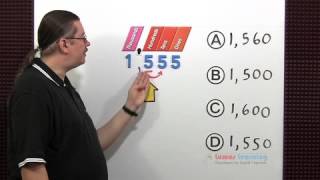Rounding numbers make it easier to work with them. Numbers can be rounded to the nearest ten, the nearest hundred, the nearest thousand, the nearest million, etc. While rounding off numbers, you need to remember that If the number you are rounding is followed by 5, 6, 7, 8, or 9, round the number up. If the number you are rounding is followed by 0, 1, 2, 3, or 4, round the number down. While rounding decimals or whole numbers, all the numbers to the right of the place you are rounding to become zeros.
The apps, sample questions, videos and worksheets listed below will help you learn Rounding Numbers
Educational Apps related to rounding numbers
Educational Videos related to rounding numbers
Related Topics
To round to the nearest cent, nearest penny, or nearest hundredth, you will need to locate the hundredths place. Then look at the digit to the right. If it is 5 or above, the number in the hundredths place will be increased by 1 and all the rest of the numbers after it are dropped.
Make the numbers that end in 1 through 4 into the next lower number that ends in 0. For example 74 rounded to the nearest ten would be 70.
Numbers that end in a digit of 5 or more should be rounded up to the next even ten. The number 88 rounded to the nearest ten would be 90.
If we want to round 4.732 to 2 decimal places, it will either round to 4.73 or 4.74. 4.732 rounded to 2 decimal places would be 4.73 (because it is the nearest number to 2 decimal places). 4.737 rounded to 2 decimal places would be 4.74 (because it would be closer to 4.74).
To the nearest ten, 33 rounds to 30. You can determine where to round without using a number line by looking at the digit to the right of the one you’re rounding to. If that digit is less than 5, round down. If it’s 5 or greater, round up.





